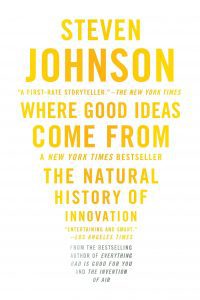
1. The Adjacent Possible:
Steven Johnson points out “Each new combination opens up the possibility of other new combinations”. Tomorrow’s innovations are built from the inventions of today. Everything surrounding us can be combined into something novel.
2. Liquid Networks:
Great ideas come from combined “liquid” networks of individuals. Steven argues that most great inventions and discoveries arise from a group of individuals exchanging various ideas and problems.
3.The slow hunch:
Life-changing ideas usually evolve over time as slow hunches rather than unexpected moments of breakthroughs. Slow hunches stay within the mind where they grow into an idea over time. Liquid networks support such thoughts to be shared around and combined with different hunches.
4.Serendipity:
Dreams can often explore the adjacent possible. Combines several independent ideas and sometimes reveal unique solutions to problems.
Sleeping with a problem has confirmed a positive influence on problem-solving skills. Reading can be used as an exceptional vessel for brewing new ideas. But spreading it over a long period can damage the connections. Bill Gates takes annual reading holidays to read large volumes of content in a short period.
5. Error:
Good ideas arise more from environments with a certain amount of error, which leads to the exploration of the adjacent possible. Errors force us to employ new approaches/strategies and to discard old assumptions, pushing us to develop something unique.
6. Exaptation:
An excellent way to innovate is to take something old, reinvent it and make it reusable again. Ideas are often repurposed too. Attempting to give something old a new use is a great way to come up with good ideas. Like how Johannes Gutenberg based his printing press on the wine screw press, a method that was over 1,000 years old at the time.
# Key Takeaways:
– Innovation and creativity are not solely the result of individual genius, but rather a product of collaboration and the exchange of ideas.
– The “adjacent possible” concept suggests that new ideas are often built upon existing ideas and technologies.
– The “slow hunch” theory proposes that great ideas often take time to develop and require a certain level of incubation.
– The “liquid networks” theory highlights the importance of diverse and open networks for the exchange and development of ideas.
– The “serendipity” factor suggests that chance encounters and unexpected connections can lead to breakthrough ideas.
# Practical Applications:
– Encourage collaboration and diversity in teams to foster the exchange of ideas and promote innovation.
– Create an environment that allows for “slow hunches” to develop and encourages experimentation and risk-taking.
– Foster open and diverse networks within and outside of the organization to facilitate the flow of ideas.
– Embrace serendipity and chance encounters, and be open to unexpected connections and opportunities.
# Valuable Insights for Leaders and Managers:
– Chapter 2: “The Adjacent Possible” – Understanding the importance of building upon existing ideas and technologies for innovation.
– Chapter 3: “Liquid Networks”- Recognizing the value of diverse and open networks for the exchange and development of ideas.
– Chapter 4: “The Slow Hunch” – Embracing the idea that great ideas often take time to develop and require patience and persistence.
– Chapter 6: “Serendipity” – Being open to chance encounters and unexpected connections as potential sources of breakthrough ideas.
# Case Studies and Examples:
– The development of the printing press by Johannes Gutenberg, which was built upon existing technologies and led to a revolution in communication and knowledge sharing.
– The story of how the discovery of penicillin by Alexander Fleming was the result of a “happy accident” and chance encounter.
– The success of Pixar, which is attributed to their open and collaborative work culture that encourages the exchange and development of ideas.
– The role of diverse networks in the creation of the World Wide Web, as highlighted by the collaboration between Tim Berners-Lee and Robert Cailliau.
Leave a Reply